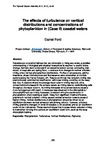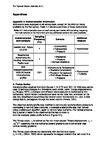The effects of turbulence on vertical distributions and concentrations of phytoplankton in (Case II) coastal waters
| dc.contributor.author | Ford, D. | |
| dc.date.accessioned | 2019-05-20T15:49:36Z | |
| dc.date.available | 2019-05-20T15:49:36Z | |
| dc.date.issued | 2017 | |
| dc.identifier.citation |
Ford, D. (2017) 'The effects of turbulence on vertical distributions and concentrations of phytoplankton in (Case II) coastal waters', The Plymouth Student Scientist, 10(2), p. 40-58. | en_US |
| dc.identifier.issn | 1754-2383 | |
| dc.identifier.uri | http://hdl.handle.net/10026.1/14159 | |
| dc.description.abstract |
Estuaries are extensive habitats that are vulnerable to rising sea levels; a detailed understanding of biological and physical interactions is required to predict future change. Surveys were conducted in an estuarine system across contrasting tidal states, of neap ebb and spring flood, to evaluate how changes in vertical turbulent mixing affect vertical phytoplankton distributions. Profiles of temperature, salinity, irradiance, shear microstructure and fluorescence were undertaken at multiple stations along the Tamar Estuary, UK. Results confirmed that turbulent mixing was predominately controlled by stratification, with lower mixing occurring on the neap ebb tide. At stations where the average water column mixing was low, chl-a concentrations increased in the surface waters as mixing was not redistributing cells throughout the water column. As mixing increased chl-a concentrations became more homogenous with depth. A decrease was observed in the chlorophyll-a / chlorophyll-b ratio as mixing increased, consistent with photoacclimation of phytoplankton when residing at depth. Away from significant riverine influence, gradients in vertical turbulent mixing caused vertical advection towards areas of higher mixing. Vertical distributions of phytoplankton should be driven by an equilibrium between vertical advection and sinking velocity. However, turbulent mixing gradients changed on small timescales (< 30 seconds) and so an equilibrium could not be maintained. These results indicate that in areas where turbulent mixing is maintained for long time periods an equilibrium could form, such as the deep chlorophyll maxima. | en_US |
| dc.language.iso | en | en_US |
| dc.publisher | University of Plymouth | |
| dc.rights | Attribution 3.0 United States | * |
| dc.rights.uri | http://creativecommons.org/licenses/by/3.0/us/ | * |
| dc.subject | Phytoplankton | en_US |
| dc.subject | Turbulence | en_US |
| dc.subject | Vertical Distributions | en_US |
| dc.subject | Pigments | en_US |
| dc.title | The effects of turbulence on vertical distributions and concentrations of phytoplankton in (Case II) coastal waters | en_US |
| dc.type | Article | |
| plymouth.issue | 2 | |
| plymouth.volume | 10 | |
| plymouth.journal | The Plymouth Student Scientist |




